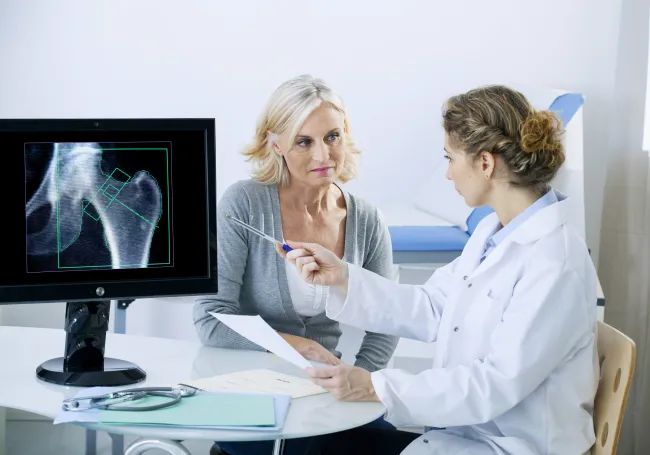A very common, serious health concern
More than 50 million Americans have low bone density or osteoporosis — which means half of all adults age 50 and older are at higher risk of breaking a bone and should be concerned about bone health.
Osteoporosis is responsible for an estimated two million broken bones per year, yet nearly 80 percent of older Americans who suffer bone breaks are not tested or treated for osteoporosis.
A simple, quick, and painless test
A bone density test is the only test that can diagnose osteoporosis before a broken bone occurs. This test helps to estimate the density of your bones and your chance of breaking a bone. Summit Medical Group recommends a bone density test of the hip and spine by a central DEXA machine to diagnose osteoporosis. (DEXA stands for Dual Energy X-ray Absorptiometry).
You can find out whether you have osteoporosis or if you should be concerned about your bones by getting a bone density test. Some people also call it a bone mass measurement test. This test uses a machine to measure your bone density. It estimates the amount of bone in your hip, spine and sometimes other bones. Your test result will help your healthcare provider make recommendations to help you protect your bones.
Are you a postmenopausal woman or man age 50 and older? Have you recently broken a bone? If you answered "yes" to both questions, you should talk to your doctor or other healthcare provider about getting a bone density test if you've never had one.

What a bone density test can do
A bone density test tells you if you have normal bone density, low bone density (osteopenia) or osteoporosis. It is the only test that can diagnose osteoporosis. The lower your bone density, the greater your risk of breaking a bone. A bone density test can help you and your healthcare provider:
- learn if you have weak bones or osteoporosis before you break a bone
- predict your chance of breaking a bone in the future
- see if your bone density is improving, getting worse or staying the same
- find out how well an osteoporosis medicine is working
- let you know if you have osteoporosis after you break a bone
Summit recommends that you have a bone density test if:
- you are a woman age 65 or older
- you are a man age 70 or older
- you break a bone after age 50
- you are a woman of menopausal age with risk factors
- you are a postmenopausal woman under age 65 with risk factors
- you are a man age 50-69 with risk factors
A bone density test may also be necessary if you have any of the following:
- an X-ray of your spine showing a break or bone loss in your spine
- back pain with a possible break in your spine
- height loss of ½ inch or more within one year
- total height loss of 1½ inches from your original height
Standard x-rays cannot be used in place of bone density tests. Unlike bone density tests, X-rays are not able to show osteoporosis until the disease is well advanced. However, X-rays can be used in addition to a DEXA to detect broken bones in the spine or elsewhere.
Preparation
- If you are pregnant or think you might be, please inform the technologist.
- Do not take any pills or vitamins containing calcium less than 24 hours before your test.
- You should not have a nuclear medicine test or barium x-rays within 7 days prior to your bone density appointment.
- If you have had surgery on either of your hips or on your lower back, please inform the Technologist prior to your test.
- Wear comfortable clothing with no metal, as it may interfere with imaging.
What to expect during test
With most types of bone density tests, a person remains fully dressed, but you do need to make sure no buttons or zippers are in the way of the area to be scanned. The test usually takes less than 15 minutes. Bone density tests are non-invasive and painless. This means that no needles or instruments are placed through the skin or body. A central DEXA uses very little radiation. You are actually exposed to 10-15 times more radiation when you fly roundtrip between New York and San Francisco!
Frequently Asked Questions
Will it hurt?
No, X-Ray is a painless test.
Is this test dangerous?
No. The amount of x-rays you will be exposed to is very small.
How long will it take?
Typically, no more than 20 minutes. It may take a little longer if you are scheduled for multiple x-rays.
When will I know the results?
Your physician should get the results in 2-3 working days.
What should I wear?
Wear comfortable clothes with no metal snaps or zippers. Sweat suits are preferred.
Are there any restrictions after the test?
No, you may resume your normal activities, and take your medications as prescribed by your physician.
